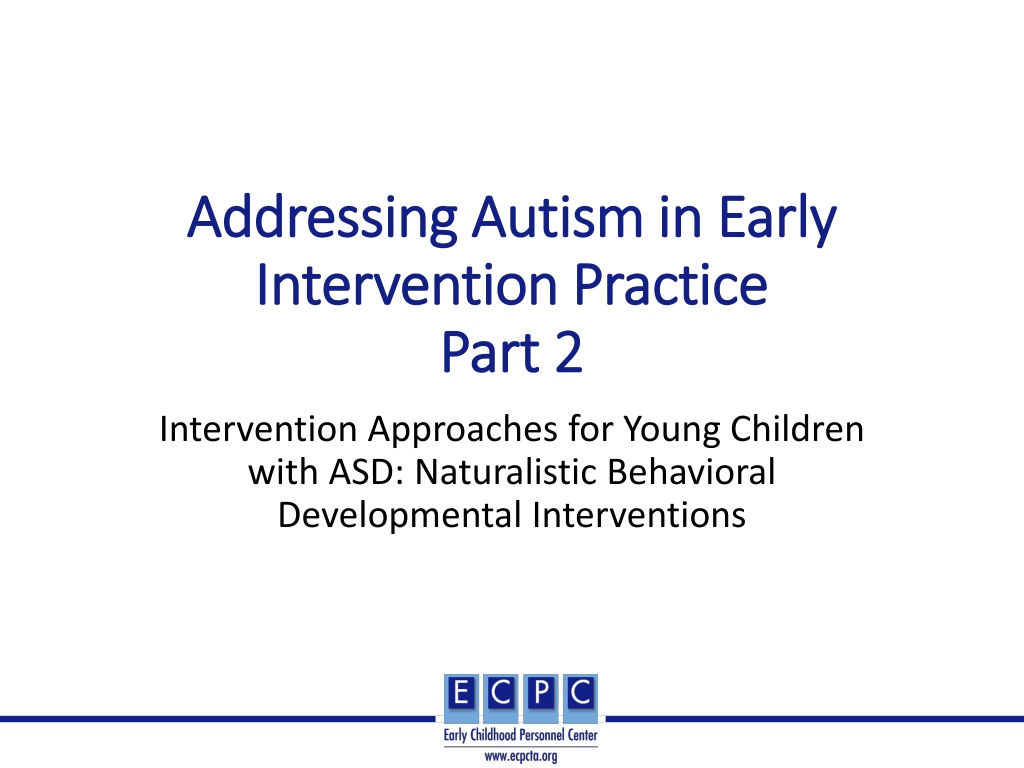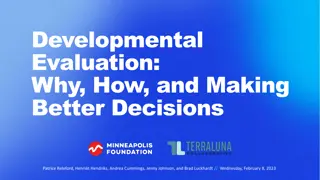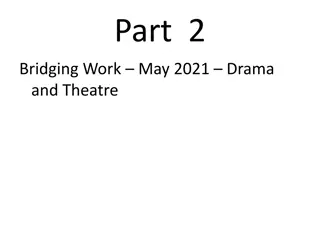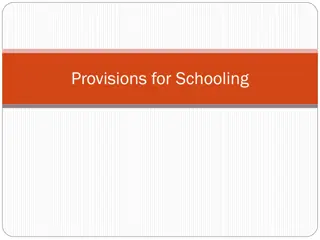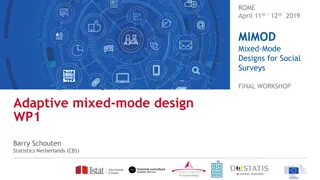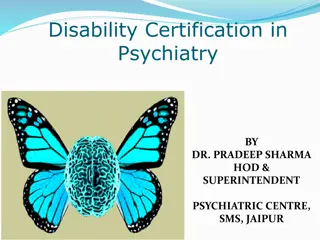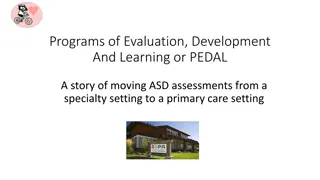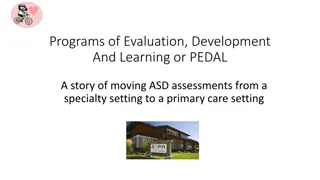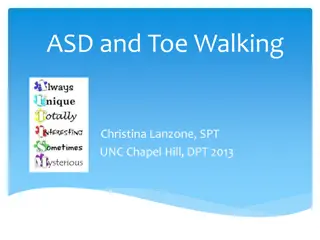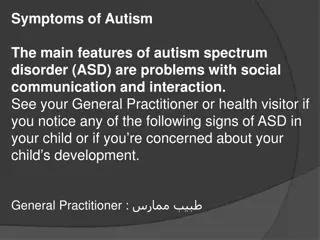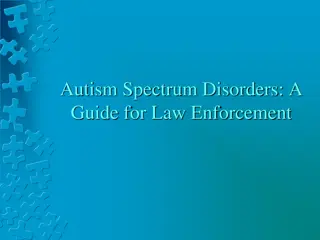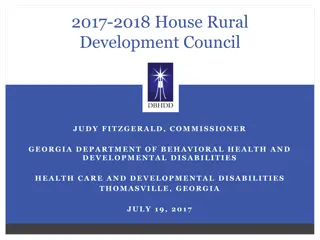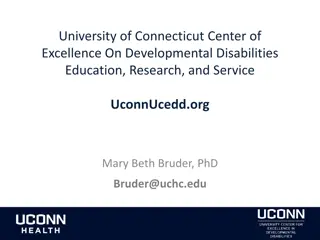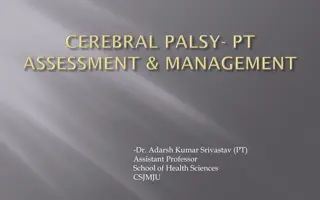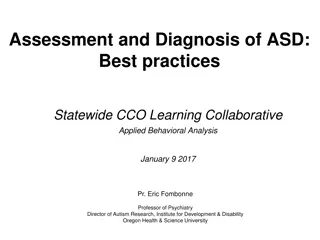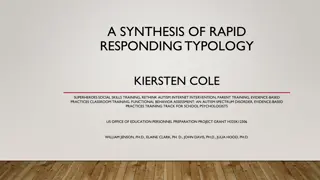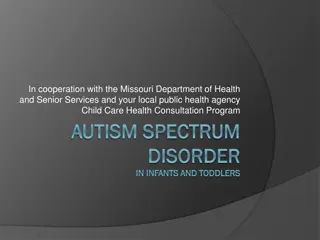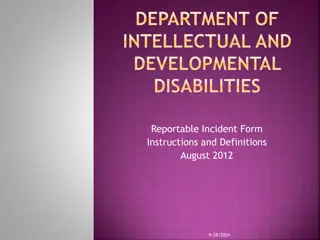Understanding Naturalistic Developmental Behavioral Interventions for Children with ASD
This resource explores the history of autism interventions, focusing on Naturalistic Developmental Behavioral Interventions for young children with ASD. It covers theoretical approaches, specific needs met by NDBIs, examples of research-validated NDBI models, and common elements used in interventions for young children. The presentation emphasizes the importance of early screening and intervention for children with ASD.
Uploaded on Jul 20, 2024 | 0 Views
Download Presentation

Please find below an Image/Link to download the presentation.
The content on the website is provided AS IS for your information and personal use only. It may not be sold, licensed, or shared on other websites without obtaining consent from the author. Download presentation by click this link. If you encounter any issues during the download, it is possible that the publisher has removed the file from their server.
E N D
Presentation Transcript
Addressing Autism in Early Addressing Autism in Early Intervention Practice Intervention Practice Part 2 Part 2 Intervention Approaches for Young Children with ASD: Naturalistic Behavioral Developmental Interventions
Autism Modules 1 and 2: Introduction Autism Modules 1 and 2: Introduction This resource, consisting of 2 modules, is designed to provide EI/ECSE professionals with a functional understanding of autism spectrum disorder (ASD) in young children, how to support early identification, diagnosis, and referral to services, and to review effective, evidence-based interventions designed for use with this population. Before you get started with this module, please create a sign-in name and password at Autism Navigator Resources: https://resources.autismnavigator.com/. After you sign in, you will have access to each of the video activities you will complete over the course of the Module.
Overview of Module 2 Overview of Module 2 Thanks to early screening efforts, thousands of children are now being diagnosed before their third birthday and referred to early intervention. Although EI/ECSE professionals are often trained in the use of ASD interventions designed for children over the age of 5 years, the EI/ECSE workforce requires access to information about evidence-based intervention models for use with the youngest children with ASD and their families, including toddlers. In this presentation, we review the elements of Naturalistic Developmental Behavior Interventions, an umbrella term for evidence-based approaches that combine the tenets of behavioral and developmental theory to integrate intervention into everyday caregiving and play routines of very young children and their families.
Objectives Objectives Describe the history of interventions for children with ASD since the 1950 s to the present day Identify the 2 theoretical approaches that inform Naturalistic Developmental Behavior Interventions (NDBIs) Identify specific ways in NDBI procedures meet the specific needs of young children with ASD List examples of commonly-used research-validated NDBI models designed for use with young children List common elements often used by NDBI interventions designed for use with young children
A Brief History of Autism A Brief History of Autism Interventions for Children Interventions for Children Until the 1960 s, it was thought that children with ASD unlikely to respond to treatment Across the 60 s and 70 s studies with children (generally over the age of three) indicated effectiveness of operant conditioning to teach language, social skills, adaptive behaviors, and reduce challenging behaviors Implemented directly with children by experts, parents were also often taught to be interventionists New field of Applied Behavior Analysis (ABA) emerged - the science of how environmental changes affect human behaviors
Lovaas Study Lovaas Study In 1987, a study was published that demonstrated huge improvements and even recovery for almost half of the children in typical school placements Led to 2 new trends: Parents advocated for early intensive behavioral treatment and insurance reform Discrete Trial Training (DTT) became increasingly popular Lovaas, O. I. (1987). Behavioral treatment and normal educational and intellectual functioning in young autistic children. Journal of Consulting and Clinical Psychology, 55, 3 9.
Discrete Trial Training (DTT) Discrete Trial Training (DTT) A highly structured operant methodology: skills are broken down into components and taught one at a time in discrete trials Used to teach basic skills to children who have not learned these skills in their natural environment An expert interventionist develops an individualized plan for the child, and uses a system of prompts and reinforcement to elicit targeted behaviors Used in Early Intensive Behavioral Intervention (EIBI) for use with children under the age of 5
Activity: Discrete Trial Training/EIBI Activity: Discrete Trial Training/EIBI Access the Autism Navigator site and sign into the Video Glossary. On the left menu, select Treatments and click on Discrete Trial Training. View the first video on the left. What behaviors was the interventionist targeting? What kind of reinforcement was being used? How would you describe the context/setting of the intervention?
Discrete Trial Training, continued Discrete Trial Training, continued While demonstrated to be moderately effective in teaching specific skills, limitations in functional benefits: Children less likely to generalize new skills across multiple environments/contexts Escape/avoidance challenging behaviors common Lack of spontaneous use of new skills Overdependence on prompts Led to changes in ABA designed for use with younger children
Combining Theoretical Constructs: Combining Theoretical Constructs: Developmental Theory and ASD Developmental Theory and ASD Intervention Intervention In the second half of the 20thcentury, research led to an increased understanding of predictable developmental sequences and early brain development
Emerging developmental theory Emerging developmental theory and ASD intervention and ASD intervention Recognition of the role of key precursors to language development, including social orienting, social engagement, joint attention and imitation
Emerging developmental theory Emerging developmental theory and ASD intervention and ASD intervention Recognition emerged that young children of all abilities learned through everyday interactions in the context of the caregiving environment
Contribution of developmental Contribution of developmental principles to interventions for principles to interventions for young children with ASD young children with ASD The work of Piaget, Bruner, Vygotsky and others demonstrates that children learn best when they are actively engaged with their everyday surroundings
Contribution of developmental Contribution of developmental principles to interventions for principles to interventions for young children with ASD young children with ASD Children acquire new skills that are just beyond their present knowledge in the context of affectively connected interactions with familiar adults and older children (e.g., Vygotsky)
Contribution of developmental Contribution of developmental principles to interventions for principles to interventions for young children with ASD young children with ASD Learning is acquired in typical sequences across domains by all children, with some exceptions (e.g., Bruner, Gibson, Mundy) Learning experiences need to be planned in a systematic manner to connect new experiences with existing knowledge (e.g., Piaget)
Contribution of developmental Contribution of developmental principles to interventions for principles to interventions for young children with ASD young children with ASD Everyday routines provide a uniquely relevant and rich context for interventions for young children with ASD
Pause and Reflect Pause and Reflect A two-year-old with ASD spends most of his day completing his favorite puzzles, does not yet use communicative gestures or words, and most often leaves the interaction when his parents prompt him to imitate their words and to point to objects during play. Using a developmental lens, what skills should be prioritized?
Naturalistic Developmental Naturalistic Developmental Behavior Interventions (NDBIs): Behavior Interventions (NDBIs): Merging Behavioral and Developmental theory How NDBI models combine the use of evidence-based strategies can differ, but always include the use of foundational behavioral and developmental tenets Strategies implemented in a multi-tiered manner to build acquisition of targeted capacities and skills over time The application of NDBI s in children s natural environments promotes generalization across behaviors and settings
NDBI Learning Targets NDBI Learning Targets Skills not taught in isolation linked to skills that are naturally used together in functional contexts Provide framework to promote functional skills, particular social communication learning - that facilitate social interactions and increase meaningful participation Range of skills that scaffold social engagement and joint attention, sharing emotions and interests, and using communication in all forms words, gestures, phrases, expressions and words
Some Foundational NDBI Learning Some Foundational NDBI Learning Targets Targets Social engagement Social head turns, eye gaze, instances or duration spent in social engagement with another Joint Engagement Functional use of gestures like pointing, showing Behavioral responses to other s invitations to share joint attention, e.g., gaze following, or following a point Use of sounds or words to invite or respond to initiations of joint attention Imitation Recognition of imitation of others Simple imitation of other s sounds, play actions, body movements Imitation and expansion of other s sounds, play actions, body movements
Examples: Empirically Validated Examples: Empirically Validated NDBI Intervention Models NDBI Intervention Models Incidental Teaching (Hart & Risley, 1975) Pivotal Response Training (Schreibman & Koegel, 2005), Early Achievements (Landa et al, 2011) Early Start Denver Model (Rogers & Dawson, 2010, Rogers et al., 2012) Project ImPACT (Ingersoll and Wainer, 2013) Joint Attention Symbolic Play Engagement and Regulation (JASPER), (Kasari et al., 2012, 2014a, 2014b, 2019)
NDBI Intervention Targets NDBI Intervention Targets Some NDBIs are focused interventions addressing a specific behavioral area, for example social communication and/or joint attention e.g., Jasper, Project Impact Others are comprehensive in nature, targeting a wider array of functioning across domains e.g., ESDM, Incidental Teaching
Activity Activity Access the Autism Navigator Website and sign Into the Video Glossary, then select Treatments View each of the following videos about a specific NDBI approach under Toddler Treatment Models Early Start Denver Model JASPER Identify the primary intervention targets for each approach
Common features of NDBI Model Common features of NDBI Model Interventions Interventions Common Features of NDBIs Common Features of NDBIs Individualized Treatment Goals and Progress Monitoring Parent Training Child-Initiated Teaching Episodes and Environmental Modifications Three-Part Contingency Natural Reinforcement Modeling/Expanding Adult Imitation of Child Language, Play, Actions and Teaching Imitation Skills Creating Opportunities for Communication and Reciprocal Interactions Direct Teaching: Prompt/Prompt Fading Manualized Practice and Fidelity Procedures
Individualized Treatment Goals Individualized Treatment Goals and Progress Monitoring and Progress Monitoring NDBI interventions use developmental sequences to develop individualized goals Many approaches (e.g., ESDM, Jasper) use an aligned assessment battery and curriculum that is developmentally sequenced for individual planning and progress monitoring Individualized goals can be broad or targeted Use a variety of assessments, observation protocols and checklists to individualize treatment and monitor progress
Parent Training Parent Training Children of all abilities learn in the context of interactions with family/primary caregivers Early intensive behavioral interventions have been shown to be most likely to demonstrate optimal outcomes, but many hours of expert intervention is not always a natural fit for very young children and families When parents are effectively trained to use intervention strategies across daily routines, the dosage of intervention and generalization/maintenance of skills can be considerably increased (e.g., Wallace & Rogers, 2010) Parent-implemented interventions associated with positive child outcomes and improved parent-child engagement, and other parent and family outcomes (e.g.,Beaudoin et al., 2019)
Three Three- -Part Contingency Part Contingency Antecedent Behavior Consequence Helps child to understand how and when to respond based on cues from environment and people Specific prompts and contingent reinforcement Use environmental arrangements to facilitate initiating and responding behaviors
Activity: Identify the ABCs Activity: Identify the ABCs Watch the video on the next slide What were the antecedents in this example? What was the behavioral response to the antecedents you observed? What were the consequences of this behavior? What might have been the purpose of this behavior?
ABC example activity ABC example activity
Environmental Modifications Environmental Modifications Setting up a child s environment to minimize distractions and overstimulation, and to increase comfort and predictability Minimize number of toys available at one time Create predictable routines Create effective boundaries in play areas of home, school Minimize screens, noise, bright lights Provide access to materials/music that support sensory regulation
Environmental Modifications, Environmental Modifications, continued continued Modification of a child s play area can optimize face-to-face interactions, child choice-making, make it easy to join the child in play, and broaden attentional focus Opportunity to choose from several toys/activities Multiple sets of preferred toys to that adults can join and imitate/mode/expand play Include mirrors, pillows, table with chairs that face each other for face-to-face engagement
Natural Reinforcement Natural Reinforcement Avoiding the use of reinforcement that is not related directly to the targeted behavior, e.g., stickers, candy, tokens Natural reinforcement occurs when a child is pleased with the consequences of his or her response for instance, after a child is imitated by an adult and the child initiates social eye gaze and smiles, or when the child gains access to a preferred toy or sensory activity when he or she successfully uses a communicative gesture, sound, or word
Child Child- -Initiated Teaching Episodes Initiated Teaching Episodes Following a child s lead child selects activity Adults create space for the child to focus on interest and join them in face-to-face play: Using imitation, comments, language and play models/expansions to provide social learning and to keep children socially engaged Adults introduce paced prompts for target skills in the context of child-selected activities without re- directing their play
Supporting Joint Attention Supporting Joint Attention Initiations and Responses Initiations and Responses Children with ASD do not develop the capacity to initiate and respond to joint attention the way that typical children do a core deficit of individuals with ASD Effective early interventions include strategies to facilitate joint attention initiations and responses by children to share attention to objects and events Strategies include arranging the child s environment to optimize social interactions and allowing time for the child to make a social bid for shared attention, and to respond to social bids by others
Activity Activity Watch this video created by Dr. Connie Kasari at the UCLA Autism Research lab to minute 1:33, which includes an explanation by Dr. Peter Mundy about the importance of joint attention as a primary intervention target Why does Dr. Mundy say that the ability to coordinate joint attention through gaze shifts from face to face, gaze following, head turns, pointing/showing are needed for functional language to develop?
Models/Expansions and Simplified Models/Expansions and Simplified Communication Communication Models: Adult/peer demonstration of a behavior that follows the child s interest or focus and demonstrates the targeted skill e.g., gestures, language, play action Expansions: Simple models can be expanded to show the child a slightly more complex example of the behavior, Green truck! and saying vroom when pushing the truck along Simplified Communication: Adults use language that matches the child s language level e.g., one or two words for preverbal children, adding just a step more complexity than the child currently uses
Activity: Child Activity: Child- -Led Activities and Led Activities and Models/Expansions Models/Expansions Returning to the video from the Kasari Autism Research Lab at UCLA, watch from 1:33 to 4:16 Identify examples of modeling, expanding, and simplified language you saw this therapist use Was she following Parker s lead in the activity throughout? What did you hear her say about the use of modeling does she use it all of the time? How does she pace the use of language and play models? What cues does she use to decide how she uses these strategies?
Creating Opportunities to Initiate Creating Opportunities to Initiate Communication/Requests Communication/Requests Using environmental modification and interactional strategies to encourage initiations of communication/requests: Put preferred items in sight and out of reach Control access to objects the child desired access to, like the next piece in a puzzle, or the next block Include activities that need the adult to help to encourage requests Pretend that you don t know how to do something child knows how to do and make it silly e.g., shoe on hand
Creating Opportunities to Access Creating Opportunities to Access Sensory Regulation Sensory Regulation Children with ASD most often have sensory challenges that limit their ability to access a regulated state When children have access to calming sensory activities through the use of movement, music, sensory materials, jumping or climbing they are more likely to connect with others and attend to social interactions Sensory activities are prioritized in some NDBI models for children who are not yet consistently interested in object play and/or are often highly dysregulated (e.g., JASPER).
Adult Animation Adult Animation Children of all abilities are naturally drawn to adults who are using a lot of positive affect, excited voices, and using expressions and gestures that convey that they are enjoying the interaction In the use of NDBI interventions, adults (interventionists, parents) are trained to use a high level of positive animation throughout their interactions with children
Adult Imitation of Childs Actions, Adult Imitation of Child s Actions, Play, Sounds/Words Play, Sounds/Words Contingent imitation/mirroring imitating the child s actions, sounds, words to signal to the child that others can see what he is doing, and are interested in joining the interaction without placing a demand for a specific response Provides an opportunity to return the imitation, or even expand on the imitation Evidence suggests that contingent imitation is effective to increase a child s attention to a social partner, especially very young children or preverbal learners (e.g., Haebig, 2013)
Creating Opportunities for Creating Opportunities for Reciprocal Interactions Reciprocal Interactions When joining child in play, offer trade of toys when both toys are interesting to the child Adult can take a short turn with a toy of interest and model a play action/expansion, and then return to the child so that he or she can take a turn Use predictable short phrase so that child knows that turn is coming up e.g., my turn! then your turn! Pace turns so that activity is enjoyable rather than frustrating
Direct Teaching: Prompting Direct Teaching: Prompting Procedures and Reinforcement Procedures and Reinforcement Direct teaching is most effective when the young child is motivated to attend to the teaching target Should be used when child is relatively well- regulated and engaged in the interaction Prompts are introduced to help child use a new skill that is just slightly more complex that what he or she is currently using
Direct Teaching, continued Direct Teaching, continued Prompts provided when child is attending to the object event of shared focus Stated clearly, simply and predictably (this teddy bear wants to ?) Use wait time (2-30 seconds depending on the child) to allow the child to respond Provide support as needed to elicit response (3-prompt rule is common in NDBI interventions) Offer reinforcement immediately, including early versions of the targeted behavior, and shape gradually Fade prompting support over time
Activity: Bringing it All Together Activity: Bringing it All Together Watch the video on Autism Navigator in the Video Glossary, under the Treatments Tab, selecting the Early Achievements option to view the video on the right of a 2-year-old with his therapist. Which of the elements we just reviewed did you observe? Child-led activities, environmental modifications, imitation, opportunities for communication and turn-taking, animation, opportunities for sensory regulation, prompting/direct teaching, natural reinforcement?
Manualized Practice with Fidelity Manualized Practice with Fidelity Clear and well described procedures and protocols Provides consistency of interventions Requires use of fidelity of intervention tools to ensure the information is transferred as intended to the parent, teachers, professionals who will implement the intervention Also requires the use of fidelity of implementation tools to ensure that the model is used as intended by the parent, teacher or professional with the child
Pause and Reflect Pause and Reflect Have you ever used a checklist or other fidelity protocol to guide how you provided an intervention? How did the use of the fidelity tool impact how you provided the intervention? Do you consistently use a fidelity tool? Why or why not?
References References Beaudoin, A. J., S bire, G., & Couture, M. (2019). Parent-mediated intervention tends to improve parent-child engagement, and behavioral outcomes of toddlers with ASD-positive screening: A randomized crossover trial. Research in Autism Spectrum Disorders, 66, 101416. https://doi.org/https://doi.org/10.1016/j.rasd.2019.101416 Dawson, G., Rogers, S., Munson, J., Smith, M., Winter, J., Greenson, J., Donaldson, A., & Varley, J. (2010). Randomized, controlled trial of an intervention for toddlers with autism: the Early Start Denver Model. Pediatrics, 125(1), e17-e23. doi: 10.1542/peds.2009-0958 Gulsrud, A. C., Hellemann, G., Shire, S., & Kasari, C. (2016). Isolating active ingredients in a parent mediated social communication intervention for toddlers with autism spectrum disorder. Journal of Child Psychology and Psychiatry, 57(5), 606-613. doi: 10.1111/jcpp.12481 Haebig, E., McDuffie, A., & Ellis Weismer, S. (2013). Brief report: Parent verbal responsiveness and language development in toddlers on the autism spectrum. Journal of Autism and Developmental Disorders, 43(9), 2218- 2227.doi: 10.1044/1058-0360(2012/11-0004)
References References Hart, B. & Risley, T. R. (1975). Incidental teaching of language in the preschool 1. Journal of applied behavior analysis, 8(4), 411-420. Ingersoll, B. & Wainer, A. (2013). Initial efficacy of Project ImPACT: A parent-mediated social communication intervention for young children with ASD. Journal of autism and developmental disorders, 43(12), 2943-2952. doi: 10.1007/s10803-013-1840-9 Kasari, C. & Patterson, S. (2012). Interventions addressing social impairment in autism. Current Psychiatry Reports, 14(6), 713-725. doi.org/10.1007/s11920-012-0317-4 Kasari, C., Lawton, K., Shih, W., Barker, T. V., Landa, R., Lord, C., Orlich, F., King, B., Wetherby, A., & Senturk, D. (2014). Caregiver-mediated intervention for low-resourced preschoolers with autism: an RCT. Pediatrics, 134(1), e72 e79. https://doi.org/10.1542/peds.2013- 3229
References References Landa, R. J., Holman, K. C., O Neill, A. H., & Stuart, E. A. (2011). Intervention targeting development of socially synchronous engagement in toddlers with autism spectrum disorder: A randomized controlled trial. Journal of Child Psychology and Psychiatry, 52(1), 13-21. doi: 10.1111/j.1469- 7610.2010.02288.x Lovaas, O. I. (1987). Behavioral treatment and normal educational and intellectual functioning in young autistic children. Journal of Consulting and Clinical Psychology, 55, 3 9. Reichow, B., Barton, E. E., Boyd, B. A., & Hume, K. (2012). Early intensive behavioral intervention (EIBI) for young children with autism spectrum disorders (ASD). Cochrane Database of Systematic Reviews, Issue 10, Art. No.: CD009260. doi: 10.1002/14651858.cd009260.pub2 Rogers, S. J., Estes, A., Lord, C., Vismara, L., Winter, J., Fitzpatrick, A., Guo, M., & Dawson, G. (2012). Effects of a brief Early Start Denver Model (ESDM) based parent intervention on toddlers at risk for autism spectrum disorders: A randomized controlled trial. Journal of the American Academy of Child & Adolescent Psychiatry, 51(10), 1052-1065. doi: 10.1016/j.jaac.2012.08.003
